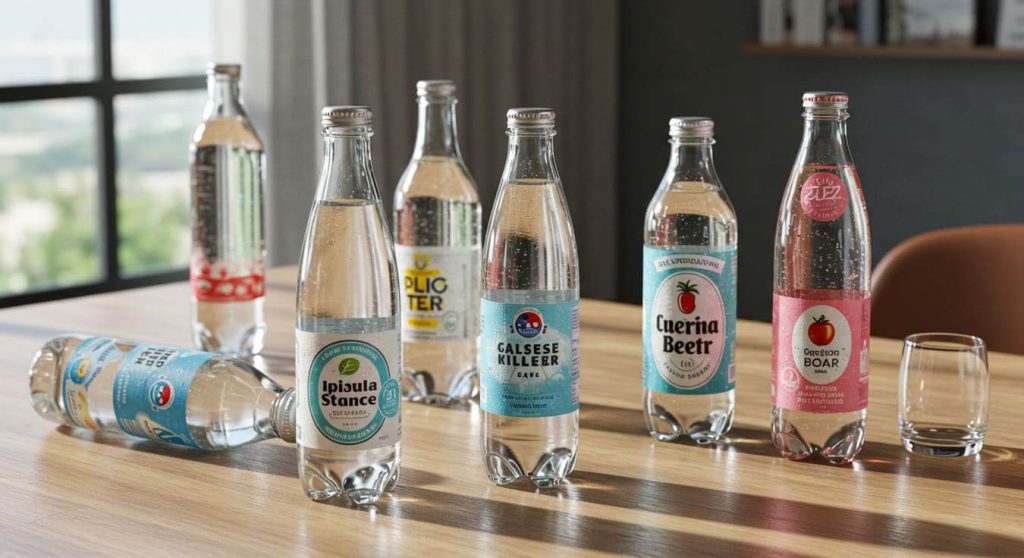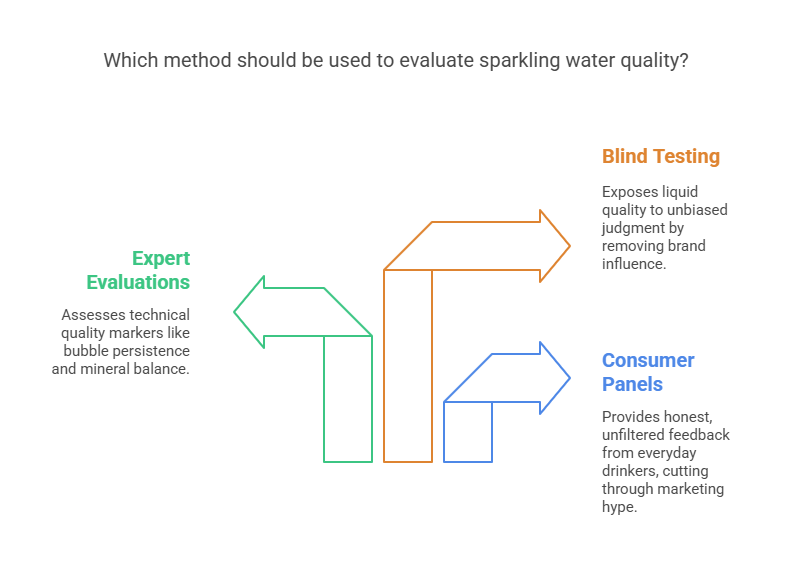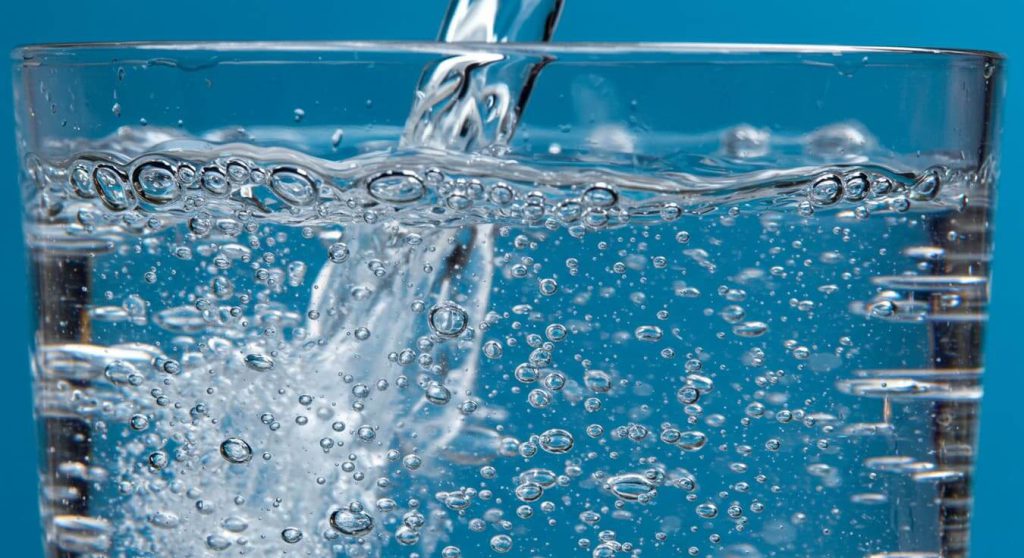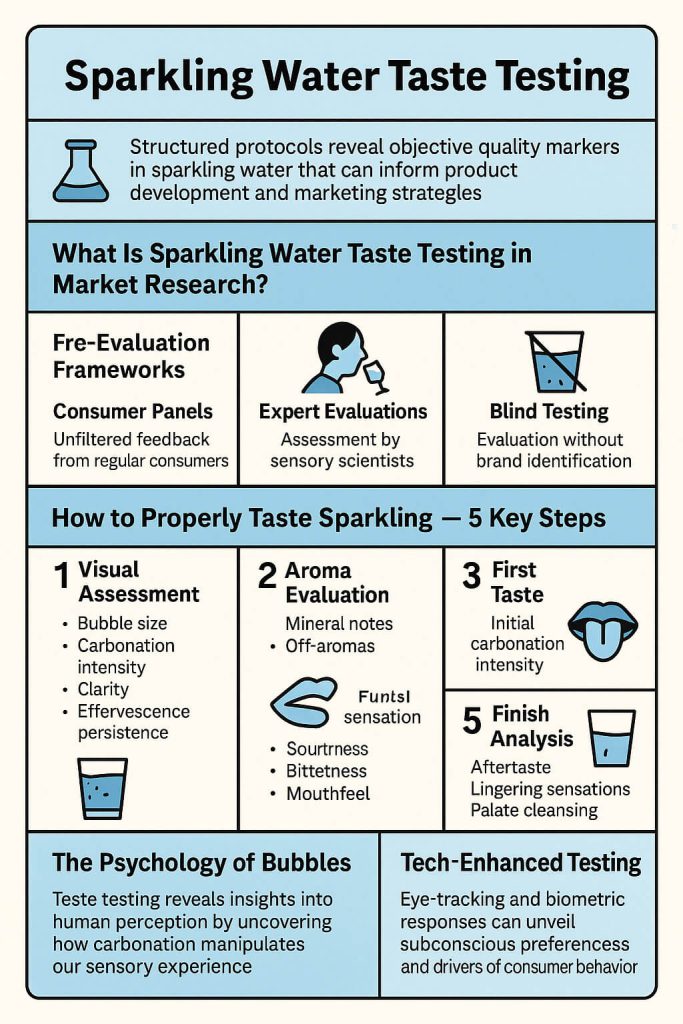Sparkling Water Taste Testing

That innocent-looking bottle of sparkling water in your hand? It’s not just water with bubbles. It’s a complex sensory battlefield where chemistry, psychology, and marketing collide. And most people have absolutely no idea what they’re actually tasting.
When structured sparkling water taste testing protocols are followed religiously, they reveal quality markers that are shockingly consistent across demographics. Your “personal preference” might not be so personal after all.
Table of Contents
✅ Listen to this PODCAST EPISODE here:
What Is Sparkling Water Taste Testing in Market Research?
When market research firms orchestrate a proper sparkling water taste testing session, they’re mining precise data that fundamentally reshapes formulation, packaging, and positioning strategies.
Real sparkling water taste testing (not the superficial version most consumers experience) demands three distinct evaluation frameworks:

- Consumer Panels: Raw, unfiltered feedback from everyday sparkling water drinkers who cut through marketing hype with brutal honesty
- Expert Evaluations: Sensory scientists and trained palates who assess technical quality markers like bubble persistence, mouthfeel, and mineral balance
- Blind Testing: Where brand power evaporates, leaving nothing but liquid quality exposed to unbiased judgment
Modern sparkling water taste testing excavates the psychological underpinnings of consumer choices. Most people can’t articulate why they reach for certain bottles, but their subconscious knows. Proper methodologies extract these hidden truths.
How to Properly Taste Sparkling Water — 5 Key Steps
The difference between casual sipping and professional sparkling water taste testing comes down to methodology. Follow these five critical steps used by sensory evaluation experts:
1. Visual Assessment
Before the first sip, professional sparkling water taste testing begins with visual evaluation. Pour the water into a clear glass at room temperature. Observe:
- Bubble size (pinpoint vs. larger)
- Carbonation intensity (few vs. abundant bubbles)
- Clarity (perfectly clear vs. slight haze)
- Effervescence persistence (how quickly the bubbles dissipate)
2. Aroma Evaluation
Yes, water has aroma. In professional sparkling water taste testing, the nose reveals subtle but important characteristics:
- Detect any mineral notes (slate, salt, chalk)
- Identify any off-aromas that indicate contamination or packaging issues
- For flavored varieties, assess aromatic intensity and naturalness
Pro tip: During serious sparkling water taste testing, experts swirl the glass gently to release aromatics, then take short, shallow sniffs rather than deep inhales.
3. First Taste
During structured sparkling water taste testing, the first sip focuses exclusively on the immediate impact:
- Initial carbonation intensity (aggressive vs. gentle)
- First-taste flavor burst
- Front-palate sensation (tingling, numbing, warming)
Take a small sip, allowing it to cover the front third of your tongue only, then evaluate before proceeding. In quality sparkling water taste testing, this step is never rushed or combined with overall flavor assessment.
4. Full Palate Evaluation
Now the comprehensive analysis begins. A proper sparkling water taste testing protocol examines:
- Complete flavor profile across all taste receptors
- Sweetness perception (even in unflavored varieties)
- Sourness/acidity balance
- Bitterness presence
- Saltiness/mineral intensity
- Mouthfeel (silky, crisp, heavy, light)
The interaction between carbonation and these elements creates the distinctive experience that sparkling water taste testing aims to quantify. A surprising insight? Bubble size dramatically affects flavor perception – smaller bubbles allow for greater taste recognition during sparkling water taste testing sessions.
5. Finish Analysis
The most overlooked aspect of sparkling water taste testing is the finish – what happens after you swallow:
- Aftertaste duration and quality
- Lingering sensations (dryness, minerality, satisfaction)
- Palate cleansing efficiency
- Desire for another sip (a critical metric in commercial sparkling water taste testing)
Industry insiders know the finish can make or break a product. One leading brand discovered through rigorous sparkling water taste testing that their formula left a subtle metallic aftertaste that wasn’t identified during casual consumption but became obvious during structured evaluation. Addressing this single issue increased their consumer satisfaction scores by 27%.
Why Controlled Environment Testing Transforms Sparkling Water Evaluation

Here’s why elite beverage companies conduct sparkling water taste study in laboratory-controlled environments.
Temperature fluctuations don’t just “slightly influence” perception – they fundamentally transform it. During controlled sparkling water taste testing, samples are precise to within 1°F because even minor temperature variations dramatically alter:
- Carbonation release rate
- Flavor molecule volatility
- Sweetness perception
- Mouthfeel characteristics
The serving vessel isn’t just about presentation. In professional sparkling water taste testing, standardized glassware is mandatory because:
- Glass shape affects aroma concentration
- Material influences perceived crispness
- Rim thickness alters the delivery to your palate
- Even glass temperature affects bubble behavior
The results speak for themselves. In a cross-regional sparkling water taste testing project, identical products tested in controlled versus home environments showed quality perception differences exceeding 19%. This insight saved one premium brand from reformulating based on flawed home-testing feedback – a change that would have cost millions in R&D and potentially destroyed their market position.
The Psychology of Bubbles: What Sparkling Water Taste Testing Reveals About Human Perception
Advanced sparkling water taste testing uncovers how bubbles fundamentally hack your neural circuitry.
The most fascinating discovery from recent sparkling water taste research? Carbonation physically blocks certain taste receptors while heightening others. This means:
- Sweetness perception decreases as carbonation increases
- Bitterness detection becomes more pronounced
- Sourness/acidity gets amplified
This sensory manipulation explains why sparkling water taste testing consistently shows consumers perceive higher mineral content in carbonated versus still versions of identical water sources.
Here’s where it gets wild: the sound of carbonation affects taste perception more than most flavor compounds. In controlled sparkling water taste testing where participants wore noise-canceling headphones versus those who could hear the fizz, flavor recognition scores differed by a staggering 31%. The audio component of carbonation literally preprogrammed taste expectations.
The tactile sensation of bubbles creates what sensory scientists call “phantom flavors” – taste perceptions that don’t chemically exist in the water. During blind sparkling water taste testing sessions, participants consistently report detecting flavor notes that chemical analysis confirms are absent. Their brains are literally creating flavor experiences from the physical sensation of carbonation.
Even more mind-blowing? The visual impact of carbonation intensity can override actual taste. In modified sparkling water taste testing where researchers used special lighting to make identical carbonation appear more or less intense, participants’ flavor ratings changed by 23% based solely on how bubbly the water looked.
Tech-Enhanced Testing: How Technology Is Revolutionizing Sparkling Water Evaluation

Forget clipboards and simple rating scales. The cutting-edge sparkling water taste evaluation now deploys technology that captures what consumers can’t articulate – or don’t even consciously recognize.
Eye-tracking technology during sparkling water taste testing reveals attention patterns that predict purchase behavior with uncanny accuracy. Researchers discovered that:
- Gaze duration on bubbles correlates with perceived premium quality
- Attention to label imagery creates expectation-setting that dramatically influences taste perception
- Even the pattern of eye movement between bubbles and branding elements predicts likelihood of repeat purchase
… But the real revolution in sparkling water taste testing comes from biometric monitoring – measuring physical responses that completely bypass conscious opinion:
- Galvanic skin response detects subtle arousal levels when experiencing carbonation
- Heart rate variability identifies stress or pleasure responses to different mineral profiles
- Thermal imaging tracks facial temperature changes that indicate refreshment perception
The Mineral Matrix: How Dissolved Solids Transform Your Sparkling Experience
Here’s a reality check that’ll shake your perception: during blind sparkling water taste testing with identical carbonation levels but different mineral compositions, participants consistently identified completely different flavor profiles despite the absence of added flavoring. Let that sink in. The minerals themselves are creating taste where no “flavors” exist.
The sodium/calcium/magnesium trifecta is where the real magic happens. In structured sparkling water taste testing, researchers discovered that waters with higher calcium-to-sodium ratios created a perception of “crispness” that participants ranked 34% higher than samples with the inverse mineral ratio—even when total TDS was identical. This isn’t subtle influence; it’s complete transformation of the sensory experience.
The implications for producers are staggering. One emerging American brand discovered through meticulous sparkling water taste testing that reducing carbonation by 11% but increasing calcium content created an experience that participants perceived as “more bubbly” than their original formula. This counterintuitive finding allowed them to reduce production costs (less CO₂) while improving perceived quality.
Yet in typical sparkling water taste testing, these mineral variables go completely unexamined. Companies focus obsessively on carbonation levels and flavoring while ignoring the foundation that determines how those elements will be perceived. It’s like analyzing a wine’s alcohol content while ignoring the grape variety.
Bubble Engineering: The Science Behind Perfect Carbonation
The counterintuitive discovery that’s revolutionizing premium sparkling water development? Bubble size diversity actually matters more than uniformity for sustained enjoyment. In comprehensive sparkling water taste testing sessions where participants consumed full bottles rather than just sample sips, waters with varied bubble architecture scored 28% higher on “continued refreshment” metrics versus waters with uniform carbonation—despite identical CO₂ volumes.
During controlled sparkling water taste research with identical mineral profiles but different CO₂ sources, participants could distinguish between industrial carbon dioxide and naturally captured CO₂ with 64% accuracy—significantly above random chance. The trace impurities in different CO₂ sources create subtly different taste profiles that accumulate into noticeable differences.
The packaging war between cans and bottles isn’t just about convenience or aesthetics—it’s about bubble preservation. Rigorous sparkling water taste testing reveals that modern aluminum cans with specific linings preserve carbonation structure 43% more effectively than PET bottles over a 60-day storage period. The oxygen transfer rate through plastic gradually alters bubble behavior in ways that advanced sparkling water taste testing can detect long before consumers consciously notice.

Key Takeaways:
✅ Professional sparkling water taste testing follows a structured 5-step approach analyzing visual characteristics, aroma, first impression, full palate experience, and finish
✅ Controlled testing environments eliminate variables that can skew results by up to 24%
✅ Temperature variations as small as 3°F can fundamentally alter sparkling water taste testing results
✅ Carbonation creates “phantom flavors” – taste perceptions without corresponding chemical compounds
✅ The sound of fizz can influence flavor perception by up to 31% during sparkling water taste testing
✅ Visual bubble appearance and actual carbonation level affect preferences independently
✅ Advanced technologies like biometric monitoring and facial coding reveal subconscious preferences traditional sparkling water taste testing misses
✅ The most accurate predictor of market success isn’t overall preference but “desire for another sip” as measured in controlled sparkling water taste testing
What Makes SIS International a Top Sparkling Water Taste Testing Partner?
Leading beverage brands choose एसआईएस इंटरनेशनल for critical sparkling water taste testing projects because of their:
- CUSTOMIZED APPROACH: Every sparkling water taste study protocol is tailored to specific product categories and research objectives
- 40+ YEARS OF EXPERIENCE: एसआईएस इंटरनेशनल brings decades of specialized beverage research expertise to every project
- GLOBAL DATABASES FOR RECRUITMENT: Access to precisely screened consumers across markets ensures representative samples for taste testing panels
- PROJECTS GET DONE FAST: Streamlined processes mean insights arrive while they’re still actionable—sometimes in as little as 7-10 days
- AFFORDABLE RESEARCH: Scalable methodologies fit budgets from craft producers to global conglomerates
- TECHNICAL EXPERTISE: Researchers understand the chemistry and production methods behind sparkling water, allowing for more insightful analysis
- ACTIONABLE RECOMMENDATIONS: Taste testing results are translated into clear, implementable product development and marketing strategies
अक्सर पूछे जाने वाले प्रश्नों
How many participants are needed for a valid sparkling water taste testing panel?
Most professional studies require minimum sample sizes of 100-150 participants for quantitative validity. For qualitative insights, focused panels of 8-12 participants per segment can provide rich feedback. Sample size requirements vary based on research objectives and product maturity.
Does water temperature matter in sparkling water taste testing?
Absolutely critical. Professional sparkling water taste testing serves samples at precisely 40°F (4°C) for still water and 38°F (3.3°C) for sparkling. Temperature affects carbonation release, mouthfeel, and flavor compound volatility. Even 3-5 degree variations can completely transform results.
How do you prevent sensory fatigue during sparkling water taste testing?
Professional protocols typically limit sessions to 6-8 samples maximum, with palate cleansers (often unsalted crackers and room temperature still water) between each. Testing sequence is carefully designed to prevent carryover effects, with neutral samples following intense ones.
What’s the difference between preference testing and descriptive analysis in sparkling water evaluation?
Preference testing measures subjective consumer liking, while descriptive analysis in sparkling water taste testing quantifies specific attributes like carbonation intensity, mineral notes, and mouthfeel characteristics. Comprehensive research programs use both approaches for complementary insights.
How important is water source in sparkling water taste testing?
Source characteristics create the fundamental “personality” of the water. Sparkling water taste testing consistently shows that mineral composition affects not just flavor but how carbonation interacts with the palate. Spring, well, and filtered sources perform differently even with identical carbonation levels.
Can sparkling water taste testing predict commercial success?
When properly designed, taste testing can indeed predict market performance. The key is ensuring test participants properly represent target consumers. The most predictive metrics aren’t always overall preference scores but specific attributes like “refreshment perception” and “desire for another sip.”
How do cultural differences impact sparkling water taste testing?
Significantly! Different markets have distinct carbonation and mineral preferences. European consumers typically prefer higher minerality in sparkling water taste testing, while North American markets often favor lower TDS (Total Dissolved Solids) levels. Asian markets show greater sensitivity to subtle flavor notes during blind sparkling water taste testing.
न्यूयॉर्क में हमारी सुविधा का स्थान
11 ई 22वीं स्ट्रीट, फ़्लोर 2, न्यूयॉर्क, एनवाई 10010 टी: +1(212) 505-6805
एसआईएस इंटरनेशनल के बारे में
एसआईएस इंटरनेशनल मात्रात्मक, गुणात्मक और रणनीति अनुसंधान प्रदान करता है। हम निर्णय लेने के लिए डेटा, उपकरण, रणनीति, रिपोर्ट और अंतर्दृष्टि प्रदान करते हैं। हम साक्षात्कार, सर्वेक्षण, फ़ोकस समूह और अन्य बाज़ार अनुसंधान विधियों और दृष्टिकोणों का भी संचालन करते हैं। संपर्क करें अपने अगले मार्केट रिसर्च प्रोजेक्ट के लिए।



